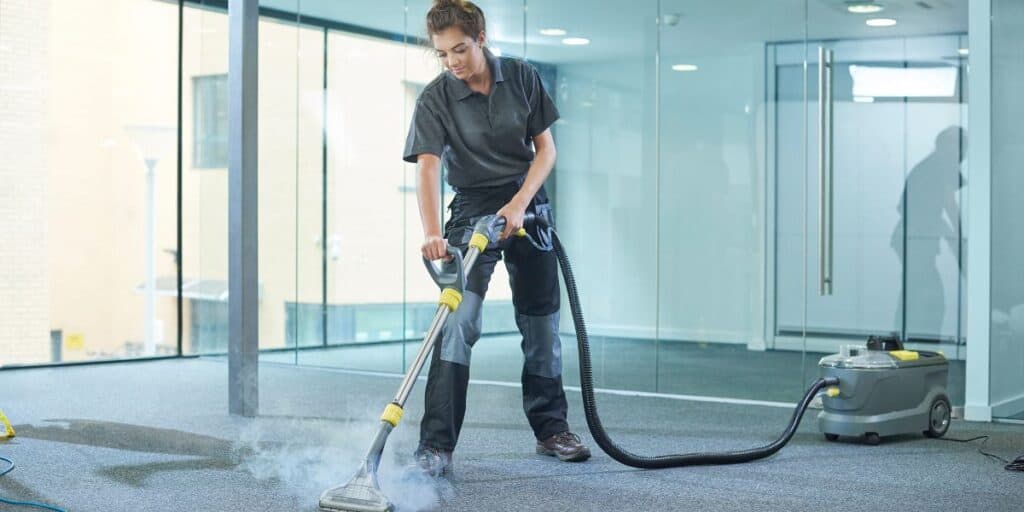Allergy sufferers know that indoor allergens can make life miserable. With dust, pet dander, and pollen getting trapped in the fibers of your carpet, you might be wondering if carpet cleaning can provide relief for your allergies.
Yes, carpet cleaning can help reduce allergies. Maintaining clean carpets significantly reduce allergens in your home, thereby making carpet cleaning techniques like HEPA vacuuming and dry steam cleaning effective in easing allergy symptoms.
In this article, we will dive deeper into the benefits of carpet cleaning for allergy sufferers, explore the different cleaning methods and their effectiveness, and share valuable tips on how to keep your carpets allergen-free. Your journey to a more comfortable, allergy-free home starts here!
Different Types of Allergens in Carpets
Carpets can be a cozy and stylish addition to your home, but they can also harbor allergens that contribute to allergies. In this section, we will explore the different types of allergens found in carpets, and how you can effectively combat them.

Dust Mites
Dust mites are microscopic creatures that thrive in the warm, humid environment of carpets. They feed on dead skin cells and produce allergenic waste. To reduce dust mite populations in your carpet, make sure to regularly vacuum with a high-efficiency particulate air (HEPA) filter. In addition, steam cleaning can help eliminate dust mites, as it generates high temperatures that kill them.
Mold and Mildew
Carpets are an ideal breeding ground for mold and mildew due to their ability to trap moisture. To prevent these allergens from developing in your carpet, ensure good air circulation, and avoid over-watering indoor plants. If you notice any signs of mold or mildew, use a carpet cleaner specifically designed for mold removal or seek professional cleaning services.
Pollen
During pollen season, it’s easy for these allergens to enter your home through open windows and doors, eventually settling into your carpets. To minimize pollen accumulation, consider using an air purifier with a HEPA filter to remove indoor pollen particles. Additionally, vacuum your carpets frequently to address the buildup.
Pet Dander
Pet dander is made up of microscopic skin particles from animals, which can cause allergic reactions for many people. If you have pets at home, make sure to bathe and groom them regularly to minimize dander production. Furthermore, maintaining a low-allergen environment by opting for hard flooring instead of carpets in specific areas where your pets spend most of their time can significantly reduce pet dander levels.
By taking these precautions, you’ll be on your way to creating a more comfortable and allergen-free living space for you and your family.
Carpet Cleaning Methods
When it comes to dealing with allergies, choosing the right carpet cleaning method is crucial. In this section, we will discuss three popular methods: Vacuuming, Steam Cleaning, and Dry Cleaning. These techniques can help reduce allergens and improve your home’s overall air quality.
Vacuuming
Regular vacuuming is essential in maintaining a clean and allergen-free carpet. It is recommended to vacuum your carpets at least once a week, or more frequently if you have pets or allergy sufferers in your household. Use a vacuum cleaner with a HEPA (High-Efficiency Particulate Air) filter, which is designed to capture more allergens, such as pet dander and dust mites. HEPA vacuum cleaning has been found effective in reducing levels of contaminants in carpets. Remember to empty the vacuum bag or canister regularly to avoid a buildup of allergens.
Steam Cleaning
Steam cleaning, also known as hot water extraction, is a popular and effective method in removing allergens from carpets. In this process, a mixture of hot water and cleaning solution is applied to the carpet, which then loosens and extracts allergens, dirt, and debris. Steam cleaning removes allergens such as dust, pollen, and dust mites while also sanitizing and deodorizing the carpet. To achieve the best results, it is recommended to have your carpets professionally steam cleaned at least once a year, or more frequently if you have allergies or pets.
Dry Cleaning
Dry cleaning is another option for maintaining a clean and allergen-free carpet. This method typically uses a machine to apply a cleaning compound to the carpet, which then absorbs dirt and allergens. The compound is then vacuumed up, leaving your carpet clean and refreshed. Dry cleaning is a faster and less intrusive process compared to steam cleaning, as it requires less drying time. However, it might not be as effective at removing deeply embedded allergens as steam cleaning. When selecting the appropriate carpet cleaning method for your home, consider factors such as allergies, level of dirt, and convenience.
By choosing the right carpet cleaning method and maintaining a consistent cleaning routine, you can significantly reduce allergens and improve the air quality in your home, which ultimately helps alleviate allergy symptoms.
Effectiveness of Carpet Cleaning on Allergies
Carpet cleaning can significantly help alleviate allergy symptoms. In this section, let’s explore how effective it is at reducing allergen levels and dive into the long-term benefits.
Reducing Allergen Levels
Regular carpet cleaning is essential to maintain a healthy home environment, especially if you suffer from allergies. Various carpet cleaning methods can effectively reduce allergen levels, such as:
- Vacuuming with a HEPA filter
- Dry steam cleaning
- Chemical treatments
To better understand the effectiveness of these methods in alleviating allergies, check out the following table:
| Cleaning Method | Allergen Reduction | Pros | Cons |
|---|---|---|---|
| HEPA Vacuuming | High | Removes dust mite allergens | Requires frequent cleaning |
| Dry Steam Cleaning | High | Kills dust mites, bacteria, and mold | Can damage some carpet materials |
| Chemical Treatments | Moderate | Targets specific allergens | May cause irritation to sensitive individuals |
Long-Term Benefits
In addition to providing immediate relief, consistent carpet cleaning offers long-term benefits for allergy sufferers:
- Preventing mold growth: Carpets trap moisture, creating an ideal environment for mold. Regular cleaning can prevent mold growth, reducing your exposure to mold allergens.
- Reducing dust mite populations: Dust mites are a common allergen found in carpets. Frequent cleaning can help keep their populations under control.
- Improving overall indoor air quality: By eliminating allergens from your carpet, you’ll significantly improve your home’s indoor air quality, which benefits not just you but also your family members.
Remember, maintaining an allergy-free environment requires continuous effort. Keep up with your carpet cleaning routine, and don’t hesitate to adjust your cleaning method if necessary to ensure that your home remains a safe haven for you and your loved ones.

Additional Tips for Allergy Relief
Choosing Hypoallergenic Carpet
When selecting a carpet for your home, choose a hypoallergenic option to help reduce allergies. These carpets are designed to prevent the buildup of allergens such as dust mites and pet dander. Carpets made of synthetic materials like nylon or polyester are often more hypoallergenic compared to those made of natural fibers like wool.
Look for carpets that have a tight weave and low pile, as these will be less likely to harbor allergens. It’s also important to avoid carpets with an excessive amount of padding, as this can create an environment where allergens can thrive.
Regular Carpet Maintenance
To keep your carpet as allergen-free as possible, establish a regular maintenance routine:
- Vacuum at least once a week using a cleaner with a HEPA filter, which limits the release of allergens back into the air.
- In addition to vacuuming, steam cleaning your carpet at least twice a year helps eliminate allergens. Make sure the carpet dries completely to prevent mold growth.
- Opt for hardwood or vinyl floors in areas of your home with high foot traffic or pet activity to minimize allergen accumulation.
Air Purifiers
Invest in a quality air purifier with a HEPA filter to help remove allergens from the air in your living spaces. Place the air purifier in areas where you spend the most time or where your carpet is located. Make sure to clean or replace the filters regularly as recommended by the manufacturer.
In addition to these steps, also make sure to dust and clean other surfaces in your home, such as drapes, blinds, and furniture, to further reduce allergens and improve your indoor air quality.
Conclusion
In conclusion, carpet cleaning does help with allergies. Regular cleaning can significantly reduce allergens, such as dust mite byproducts and pet dander, that accumulate in your carpets 1. By doing so, you can create a healthier and more comfortable living environment.
There are various methods available for carpet cleaning, and some are more effective than others. For instance, using a HEPA vacuum cleaner can greatly reduce the amount of allergens in your carpets 2. Additionally, dry steam cleaning has been found to be effective in reducing levels of allergens 3.
Moreover, it’s essential to understand that a clean indoor environment can make a significant difference in the overall air quality and how it affects your allergies. For example, taking steps like limiting the number of carpets in your home or office and ensuring proper ventilation can decrease the allergen burden 4.
To make the most significant impact on reducing allergies in your living space, you should:
- Regularly vacuum your carpets with a HEPA vacuum cleaner
- Consider dry steam cleaning for a more thorough allergen removal
- Limit the number of carpets and rugs in your home, as they can harbor allergens
- Ensure adequate ventilation to prevent the buildup of allergens and foster a healthier indoor environment
By following these suggestions, you can help create a living space that is more allergen-free and comfortable, improving your quality of life.
Frequently Asked Questions
How can I reduce allergens in my carpet?
To reduce allergens in your carpet, make sure to vacuum regularly using a HEPA filter-equipped vacuum, wash area rugs frequently, use allergen-proof covers for furniture cushions, and opt for a professional carpet cleaning service as needed.
Is steam cleaning effective for allergy sufferers?
Yes, steam cleaning can be effective for allergy sufferers as it uses high-temperature water vapor to remove dirt, allergens, and dust mites from your carpet without the need for chemicals.
How often should I clean carpets to minimize allergies?
To minimize allergies, it’s recommended that you vacuum at least once a week and steam clean your carpet every 6-12 months. High-traffic areas and homes with pets may require more frequent cleaning.
Can a professional carpet cleaning service alleviate allergy symptoms?
Yes, a professional carpet cleaning service can help alleviate allergy symptoms by effectively removing allergens, dust mites, and other irritants from your carpet. This leads to improved indoor air quality, which can help reduce your allergy symptoms.
Are certain carpet materials better for allergy sufferers?
Allergy sufferers may prefer low-pile carpets made of materials like nylon, olefin, or polyester due to their resistance to allergen buildup. However, hardwood, laminate, or tile floors can be an even better choice for reducing allergen exposure.
Do regular vacuum cleanings help reduce allergies?
Absolutely! Regular vacuum cleanings can significantly help reduce allergies by removing allergens, pet dander, and dust from your carpet. Make sure to use a vacuum with a HEPA filter for maximum effectiveness.
